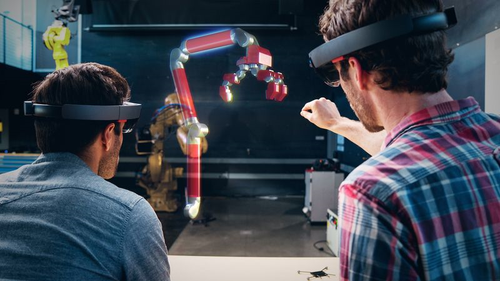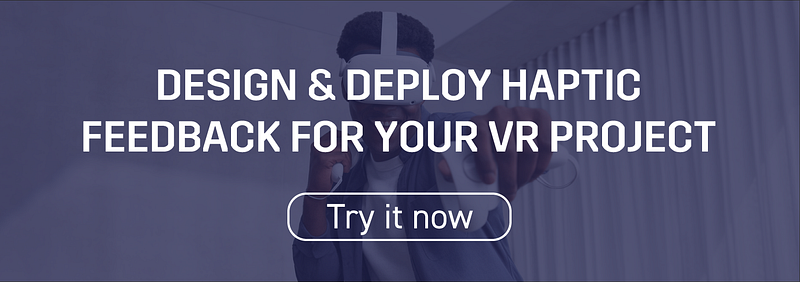This article “Haptics Applications in VR: Virtual Prototyping“ was extracted from the Recommended Practices for Haptics in Enterprise VR published by the Haptics Industry Forum.
Overview of virtual prototyping use case
Efficient digital prototyping involves simulating objects’ behavior under real-world operating conditions; therefore, sensorial experience is as important as the visual one. While VR makes it possible to model systems and interactions visually, haptics makes these interactions lifelike. This will increase the perceived realism of the user while performing design and review cycles.
An example of a virtual prototype use case is an Augmented Reality application with haptics exoskeletons created by Fraunhofer IEM in a joint research project with Hella Headlights. With a combination of a paper mock-up of an assembly cell, an AR headset, and the haptics device, Hella was able to optimize its design for manufacturing processes in the early product development stage.

What should be considered while planning to include haptics in a virtual prototyping solution?
● Application maturity: A successful virtual prototyping application requires the user to be familiar with virtual reality technology and have successfully delivered proof of concepts validating the ROI.
● Developer/Integrator capabilities: The developer and integrator capabilities are important factors to consider while engaging with VR prototyping content creation. Virtual prototyping applications are well served with refined accessibility features.
● CAD to VR pipeline: One of the key aspects of virtual prototyping is the implementation pipeline for CAD data to enable the review process.
● Multi versus single-player: Shared experiences help users to speed up the virtual prototyping process through real-time communication.

Which are the key values to adopt a virtual prototyping solution?
Compared to traditional prototyping, virtual prototyping brings several essential advantages. Among them you can find:
● Cost reduction: both for physical and traditional digital prototyping.
● Faster development cycles.
● Standardization of solution: only one generic solution for all digital prototyping efforts.
● Portability: a VR solution can be positioned anywhere, even in a home environment.
● Teamwork easing: VR offers multiplayer solutions where several engineers can be present during the assessment of the digital prototype.
Why should you include haptics in your virtual prototyping solution?
Haptics can bring value to virtual reality use cases in a different way, in the VR prototyping case, there are 3 key values haptics can bring to VR:
● Haptics enhances realism. A similar behavior between the virtual and real environment facilitates an informed understanding of human behavior. The improved perceived realism makes it easier for the user to make decisions on the UX, manufacturability, or ergonomics of a virtual prototype.
● Haptics enhances the immersion of the user. Haptics can enhance the users’ immersion during the execution of a test. Enabling a more realistic and engaging testing environment.
● Haptics enhances the user experience. Haptics or hand tracking enables an interaction that does not require a learning curve, rather than with controllers where every interaction is programmed differently. This enables the opportunity to work with untrained users. This can be critical in testing virtual prototypes on user behavior.

Which haptics characteristics should you optimize while designing your content and choosing your haptics device?
● Wearability. Virtual prototyping needs to meet operational targets to justify its ROI. The haptics device used for these applications should be easy to wear, comfortable, and it should not impede users’ natural movements.
● Embodiment. The embodiment of the haptic technology should be fit for the right purpose. Is the objective to perform simple ergonomic analysis or to provide designers with a tool to evaluate a prototype from a remote space? Or is the objective to digitalize the objective of a clay model in the automotive design process? Both situations require a different embodiment. The transparency of the solution should be based upon the desired fidelity and the associated ROI of the solution.
● Scalability (hours of use, number of deployments, etc.). One of the key aspects to consider when thinking about haptics in VR is the origin of scalability. Do you need repeatability of the same content on different premises, to target hundreds if not thousands of users? Or are you looking to create a one-of-a-kind setup for critical operation training for specific applications? Both scenarios have different needs and requirements that can be addressed by different haptic devices.
● Integration of non-haptic peripherals and mock-ups. Mixed reality mock-ups are a very good way to rapidly iterate in prototyping. Consider whether your haptic solution can interact with the physical part of the mock-up and whether it is able to simulate the right fidelity of haptics.
● Content enablement. The trade-off that should be considered is the ease of implementation against the quality of haptics. Standard haptic interaction might be compatible with direct CAD to VR pipeline solutions; more detailed haptic interactions would require tailored integrations.
Who is Interhaptics?
Interhaptics is a software company specialized in haptics. Interhaptics provides hand interactions and haptic feedback development and deployment tools for virtual reality (VR), mixed reality (MR), mobile, augmented reality (AR), and console applications. Interhaptics’ mission is to enable the growth of a scalable haptics ecosystem. Interhaptics strives to deliver top-notch development tools for the VR/MR/AR, mobile, and console developer community, and the interoperability of haptics-enabled content across any haptics-enabled platform.

If you are interested in designing high-fidelity haptics or integrating haptic feedback into your virtual reality (VR) project, download Interhaptics Haptics for VR and MR. To collaborate with Interhaptics on your AR/VR/MR project, you can contact us here.






